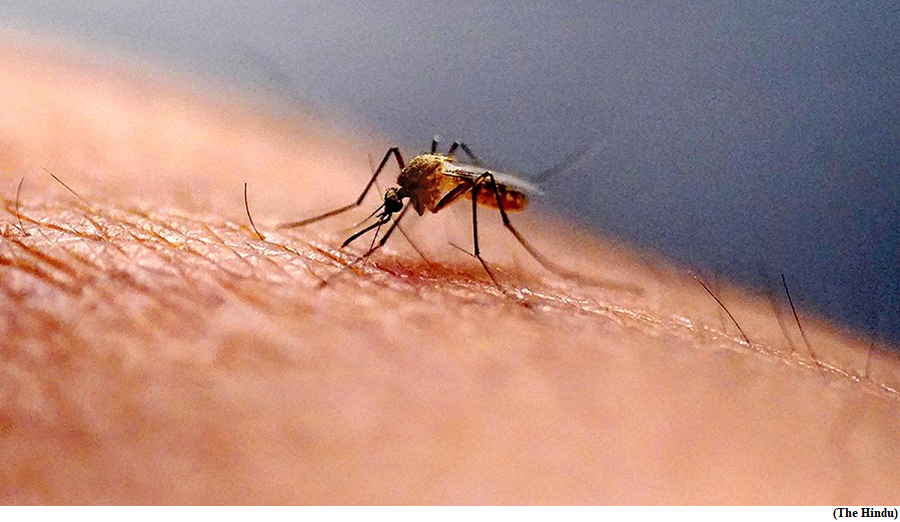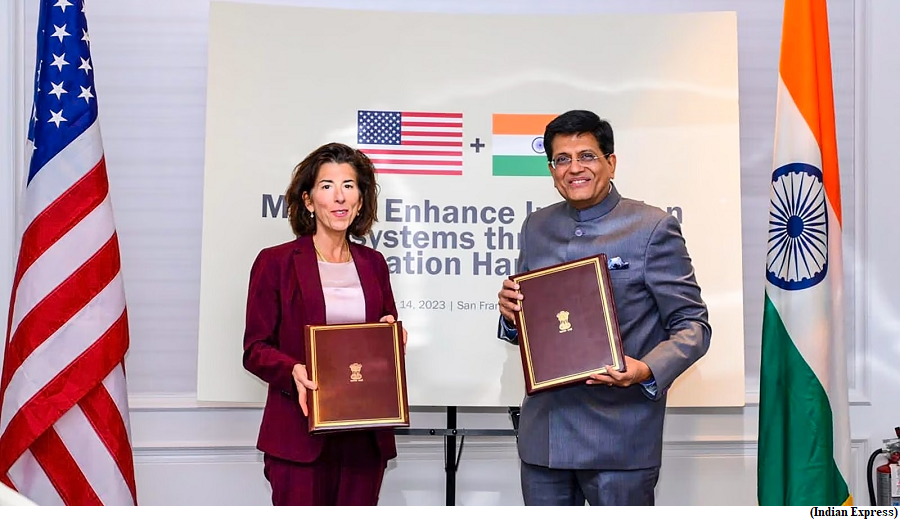Sand and dust storms are increasing, human activities contribute 25 percent emissions, UNCCD (GS Paper 3, Environment)

Why in news?
- Human activities contribute 25 per cent of global dust emissions, with agriculture being the main anthropogenic source, according to the United Nations Convention to Combat Desertification (UNCCD).
- UNCCD, which is one of three Conventions that originated at the 1992 Earth Summit in Rio de Janeiro, released policy recommendations during a five-day meeting in Uzbekistan.
Why it matters?
- Every year, more than two billion tonnes of sand and dust travel over thousands of kilometres through the Earth’s atmosphere.
- Sand and dust storms are a meteorological phenomenon characterised by strong and turbulent winds lifting an ensemble of small particles to great heights. They are known to have adverse impacts on human health, the environment and economies.
- Sand and dust storms present a formidable challenge to achieving 11 of the 17 Sustainable Development Goals.
Sources:
- The main sources of sand and dust storms are the world’s drylands. About 75 per cent of emissions come from natural sources such as hyper-arid regions, topographic depressions in arid areas and dry ancient lake beds with little vegetative cover.
- Anthropogenic factors such as land-use change, agriculture, water diversion and deforestation contribute to the remaining 25 per cent.
- Abandoned cropland, for instance, are a source of sand and dust storms. Further, water consumption in agriculture shrinks water bodies, creating new sources of sand and dust storms.
- For example, the excessive diversion of water from rivers in Central Asia over several decades towards agriculture has shrunk the Aral Sea, a pre-existing lake between Kazakhstan to its north and Uzbekistan to its south. It has now become the Aralkum Desert, a significant new source of sand and dust storms.
- Climate change, too, plays a role. Extreme wind events, aridity and frequent, severe and longer droughts worsen the storms.
- Other factors such as high air temperature, minimal precipitation and strong winds also act as drivers.
Impacts:
- Sand and dust storms lower the yields and productivity of crops, trees, pastures, and livestock. However, many of these impacts have not yet been well-quantified.
- For instance, a sand and dust storm that lasted for two days in mid-March 2021 affected an estimated 8,000 people in 2,000 households across 14 of Mongolia’s 21 provinces. Further, 10 people lost their lives and 1.6 million livestock were reported missing.
- Also, there is no policy to address the risks posed by sand and dust storms.
Way Forward:
- The FAO calls for the establishment of risk monitoring and early warning systems. This will enable the timely issuing of alerts and early warnings.
- It also recommended the strengthening of risk governance of sand and dust storms and increased investment and financing in sand and dust storm risk reduction and impact mitigation measures in agriculture along with developing national capacity and raising awareness of sand and dust storms.
How was the first vaccine for chikungunya approved
(GS Paper 2, Health)
Why in news?
- Recently, the world’s first vaccine for chikungunya was approved by the Food and Drug Administration (FDA) in the U.S.
- The vaccine has been developed by European vaccine manufacturer Valneva and will be available under the brand Ixchiq, and has been approved for administration in people who are 18 years or older, and are at increased risk of exposure to the virus.
- It was approved using the Accelerated Approval pathway, which allows the FDA to clear certain products for serious or life-threatening conditions based on evidence of a product’s effectiveness that is likely to provide clinical benefit.

What is Chikungunya?
- Chikungunya, is characterised by severe joint pain and impaired mobility, and comes with fever.
- It is a viral infection (CHIKV) transmitted primarily by the Aedes aegypti and Aedes albopictus mosquitoes and has been described as “an emerging global health threat.”
- Chikungunya is prevalent in Africa, Asia, and the Americas; but sporadic outbreaks have been reported in other regions.
- Since 2004, outbreaks of CHIKV have become more frequent and widespread, partly due to viral adaptations allowing the virus to be spread more easily by the Aedes albopictus mosquitoes.
Symptoms:
- The joint pain is often debilitating and varies in duration; it can last for a few days, but also be prolonged over months.
- Other symptoms include joint swelling, muscle pain, headache, nausea, fatigue and rash. While severe symptoms and deaths from chikungunya are rare and usually related to other coexisting health problems, it is believed that the numbers are generally underestimated, because chikungunya is often misdiagnosed as dengue or zika, as symptoms can seem similar.
Treatment:
- As of now, there is no cure, only symptomatic relief, with analgesics to help with the pain, antipyretics for the fever, rest, and adequate fluids.
- Prevention includes mosquito control activities, primarily falling under public health outreach and routine civic maintenance. .
What is the vaccine composition?
- Ixchiq is administered as a single dose by injection into the muscle. It contains a live, weakened version of the chikungunya virus and may cause symptoms in the vaccine recipient similar to those experienced by people who have the disease.
- The most reported side effects by vaccine recipients were headache, fatigue, muscle pain, joint pain, fever, nausea and tenderness at the injection site.
- The effectiveness of the vaccine was based on immune response data from a clinical study conducted in the U.S. in individuals 18 years of age and older.
- In this study, the immune response of 266 participants who received the vaccine was compared to the immune response of 96 participants who received the placebo.
- The level of antibody evaluated in study participants was based on a level shown to be protective in non-human primates that had received blood from people who had been vaccinated.
India, US, 12 other IPEF members ink supply chain resilience agreement
(GS Paper 2, International Relation)
Why in news?
- India, the US and 12 other members of the IPEF grouping have signed a supply chain resilience agreement.
- It would provide benefits like potential shifting of production centres in critical sectors and mitigating risks of economic disruptions from supply chain shocks.

Details:
- The agreement was signed in San Francisco, during the ministerial meeting of the Indo-Pacific Economic Framework For Prosperity (IPEF).
- The agreement would help member countries like India to reduce its dependence on China.
- The COVID outbreak had severely disrupted the global supply chain, as most countries were dependent on China for various products, like pharma raw materials.
- The benefits of the pact include supply chain diversification, mobilisation of investments, deeper integration of India in global value chains, support to MSMEs and creation of a seamless regional trade ecosystem, which would facilitate the flow of Indian products.
Key Highlights:
- Under the agreement, IPEF partners seek to provide a framework to build their collective understanding of significant supply chain risks; improve crisis coordination and response to supply chain disruptions; facilitate cooperation, mobilise investments, promote regulatory transparency in sectors and goods critical to national security and public health and safety.
- The critical sectors would be identified by the member countries.
Monitoring:
- To implement and monitor the agreement, the bloc would set up the IPEF Supply Chain Council.
- The council will meet every year and all the members would have to report on the progress of implementation of the agreement.
- Besides the council, the block would set up the IPEF Supply Chain Crisis Response Network and the IPEF Labor Rights Advisory Board.
- The network would deal with emergency issues and help partners to seek support during a supply chain disruption and to facilitate information sharing and collaboration among IPEF partners during a crisis, enabling a faster and more effective response that minimises negative effects on their economies.
- On the other hand, the advisory board would help members in promoting labour rights in their supply chains.
About IPEF:
- IPEF was launched jointly by the US and other partner countries of the Indo-Pacific region on May 23, 2022 in Tokyo.
- The framework is structured around four pillars relating to trade, supply chains, clean economy and fair economy (issues like tax and anti-corruption). India has joined all the pillars except the trade one.
- Australia, Brunei Darussalam, Fiji, India, Indonesia, Japan, Republic of Korea, Malaysia, New Zealand, Philippines, Singapore, Thailand, the US and Vietnam are members of the bloc.
- It would come into force after the implementation of the agreement by any of the five member countries.




